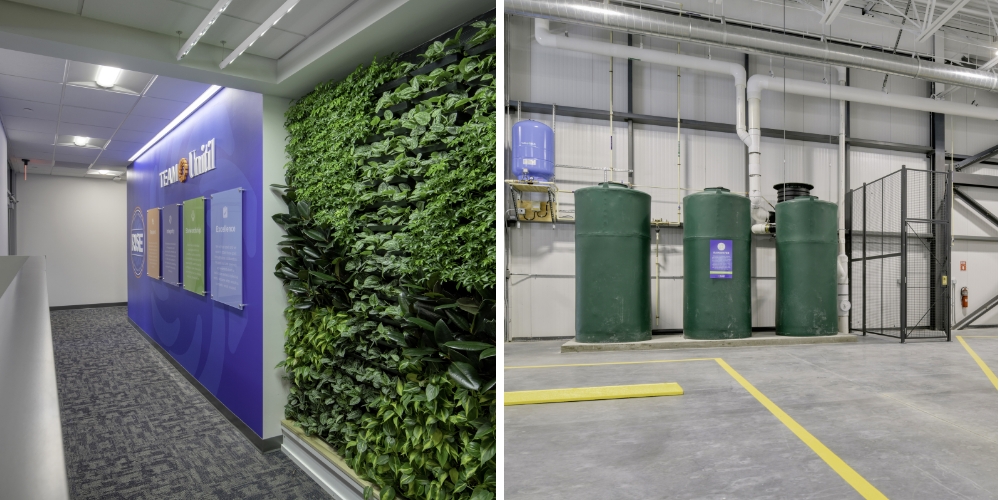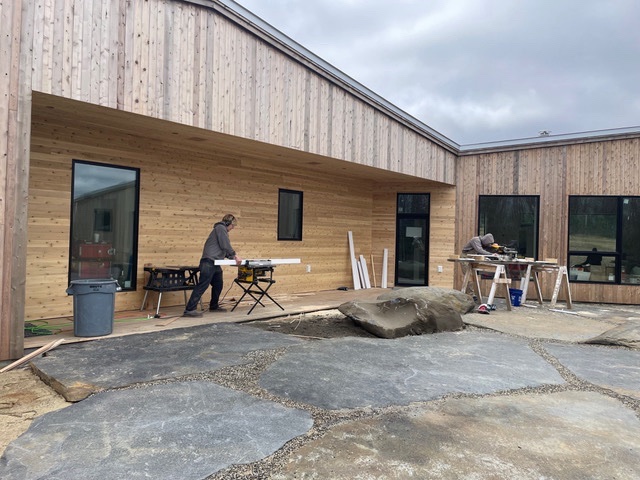
“From an architectural perspective it’s fairly broad,” says Tracy Kozak, founding principle of Arcove Architects in Portsmouth and chair for the Committee on the Environment for the NH chapter of the American Institute of Architecture (AIA). “Sustainable building encompasses energy and carbon of course, but also what we call resilience, which is the ability for a built place to endure over time. And it also incorporates a healthy environment as well.”
While there is no all-encompassing definition for what makes a building sustainable, there are numerous criteria and standards that architects and builders, as well as businesses and homeowners, can use as guides.
The AIA Framework for Design Excellence, though, represents the defining principles for sustainable design, says Kozak. The framework is comprised of 10 principles that help architects and builders move toward a zero-carbon, healthy, just, resilient and equitable built environment. Those principles are designing for: integration, equitable communities, ecosystems, water, economy, energy, well-being, resources, change and discovery.
Kozak says the other New England states have stricter standards for sustainable design than NH and that Massachusetts is leading the way. “Massachusetts has stricter energy codes for buildings,” she says. “And that makes sense because the payoffs can be pretty quick.”
Sustainable Building Certification
For developers and builders interested in building sustainably, various certification programs exist that provide standards. The WELL standard and LEED are two of the most common.
The WELL Building Standard, created by the International WELL Building Institute (IWBI) in 2014, is a standard that some developers and builders turn to when their goal is to enhance well-being and health. According to the International WELL Building Institute, a study analyzing the impact of WELL Certification found “WELL Certification improved overall occupant satisfaction by nearly 30%, as well as occupant perceived well-being scores by 26%, reported mental health scores by 10% and productivity gains by 10 median points.”
For those interested in energy efficiency, one of the most popular certification programs is LEED, which stands for Leadership in Energy and Environmental Design. LEED was introduced by the U.S. Green Building Council in 1994 and is used for both new building projects and renovations. LEED certification is a points-based system that grades efforts that address carbon, energy, water, waste, transportation and more.
So what is the return on such investments? A Journal of Environmental Economics and Management study in 2019 found that green buildings cost 6.5% more to develop on average, but those buildings have been shown to rent for 13.3% to 36.5% more. A Green Building Council study shows that green buildings can have a payback period of as little as three to five years, with a return on investment of up to 40% over the building’s lifetime.
LEED credits, which can be combined with WELL certifications, can also be incentivized through state programs, such as NH Saves, which offers energy savers rebates. If a project meets certain standards, covering a range of metrics from sustainable building materials to energy use, it is given one of four certifications ranging from basic certification to platinum.
“Of all LEED credits, 35% relate to climate change, 20% directly impact human health, 15% impact water resources, 10% affect biodiversity, 10% relate to the green economy and 5% impact community and natural resources,” according to the U.S. Green Building Council.
LEED certification is much more popular than it was 20 years ago, says Michael Lawrence, an architect for PROCON, a single-source, architecture, engineering and construction management firm in Hooksett. “LEED was really the first certification that became widely known,” he says, explaining other certification programs exist including Energy Star. “This pushed a lot of manufacturers to do more with recycled content, like carpeting and ceiling tiles. The products we’re using today are a lot more sustainable than they were then.”
Lawrence says the level of sustainability varies by project. “Not a very high percentage of our projects are sustainable by all certification standards, but principles of sustainability go into almost every project,” he says. “Most new construction, for instance, is highly energy efficient.”
 Left: Unitil Live Wall Corridor, Right: Unitil rain water tanks. (Courtesy of PROCON)
Left: Unitil Live Wall Corridor, Right: Unitil rain water tanks. (Courtesy of PROCON)
Lawrence says PROCON recently completed a 54,000-square-foot distribution center for Unitil in Exeter that is WELL certified. WELL certification isn’t just about the building, Lawrence says, but how people live and work inside of it. Meeting WELL certification standards required PROCON to focus its attention on things like availability of natural light, hand washing and healthy eating.
“Because of the WELL certification, [Unitil] needed to have a certain percentage of their workstations located close to windows,” Lawrence says. To encourage proper handwashing, PROCON installed soap dispensers that use fragrance-free soap. Unitil also wanted WELL credit for healthy eating, Lawrence says, and made sure there was space for healthy options, including vendors like 6am Health stations (a vendor providing healthy food options) inside breakrooms.
And the Unitil building also has a Green wall that allows nature inside. “This is a live wall with vegetation that has irrigation built in,” Lawrence says.
The facility is also LEED certified and includes vehicle washing bays that use rainwater collected from the roof. “Those types of things, as well as the inclusion of solar panels is wonderful. And it’s a well-insulated building,” he says.
Doug Shilo, a project designer and sustainability leader at Lavallee Brensinger Architects, an architectural firm with offices in Manchester, Boston and Portland, Maine, points to the Oyster River Middle School, completed in 2022, as a project that qualified for LEED Gold status.
“Ultimately they went with LEED because of the name recognition in terms of sustainability,” says Shilo, who was the lead administrator for the project tasked with documenting LEED criteria. “They wanted a net-zero ready building and having a third-party verification of that was something they could show their voting base.”
Shilo says the parking area at the middle school is a good example of using space wisely to attain sustainability. Architects used geothermal heat from below the parking area to provide heat for the school. Typical heat pumps draw from the air, Shilo explains, adding that getting heat from 30-degree air can be tough. “That parking area works triple time,” Shilo says, “It includes parking, heating and solar panels, and once those panels are owned, it reaches the district’s goal of net zero.”
Due to its LEED certification, the middle school received a status of general sustainability. The school district was able to use incentives such as rebates on heating and water heating equipment through the NH Saves program, a collaborative of NH’s electrical utilities. “Oyster River had a great performance and achieved net-zero-ready status, which led to incentives to the tune of hundreds of thousands of dollars,” Shilo says.
Kozak says that while the NH Saves program has been “wonderful” for incentivizing energy efficiency, overall NH is “not the greatest” when it comes to incentives. “Incentives for solar and heat pumps come under attack every year,” she says, referring to legislation like HB 549 in 2022 that limited the growth of energy efficiency programs by setting a cap on funding.
Businesses Want Higher Energy Performance
Shilo says businesses have started to request more energy performance and embodied carbon standards for their buildings. Embodied carbon refers to the amount of carbon used in the construction of a building. “We’ve been fortunate enough to be able to provide these calculations for a few different clients,” he says. “Often there is as much energy and carbon that goes into building construction as there is in using the building.”
Carbon is contained in the superstructure of a building, which primarily includes concrete, wood and steel. “This is where we can make biggest impact,” Shilo says, explaining that for developers wishing to reduce their carbon footprint, finding alternatives to traditional materials is crucial. Replacing Portland cement with products such as slag, or fly ash, both byproducts of industrial processes, can reduce a building’s carbon footprint by removing the need to crush and burn limestone that releases carbon, Shilo says.
“The energy it took to make the building is already there,” Kozak says. “Materials that last a long time may cost a little bit more in the beginning, but you don’t have to replace them in 20 or 40 years. A lot of the buildings constructed in the eighties and nineties were designed for a standard 50-year life span or even less. And we’re seeing that now with these buildings built in 1980; some people are saying ‘let’s knock it down and start over,’ and it’s such a waste; they just go to the landfill.”
The Green Building Council reports that buildings are responsible for 39% of global energy-related carbon emissions: 28% from operational emissions (energy needed to heat, cool and power them), and 11% comes from materials and construction.
“We can’t solve the climate crisis without fixing how we make all of the links with sustainability,” Kovak says, explaining that retrofitting existing buildings, which is part of her firm’s specialty, can also reduce carbon. “We need to not just build new buildings better but make the existing buildings more energy efficient. There’s a lot of embodied carbon already in our existing buildings. It doesn’t always make sense to tear them down and build new ones.”
Kozak is committed to being part of the solution to the energy crisis. One way to do this, she says, is to find the right materials that are easy to repair. “Windows are a good example. In Portsmouth there are buildings with 200-year-old windows and people believe they take so much maintenance,” she says, but replacing them with cheaper windows ends up costing more than maintaining the originals in the long term.
And sometimes simple solutions to energy loss, like making sure roof to wall and foundations are sealed properly, and having proper insulation, can go a long way. “It matters where you put your money,” she says.

A net-zero energy home in Sheffield, Vt. built by Garland Mill. (Courtesy of Garland Mill)
A Generational Commitment to Sustainable Building
Sustainability is built into the DNA and history of Garland Mill, a design-build construction firm that owns the only commercial sawmill in NH still operating solely by waterpower.
It is housed on the site of a sawmill built by Eben Crocket Garland in 1856 on the banks of Garland Brook in Lancaster, and the water from that brook provides the power to saw logs into timber and lumber for the buildings that it constructs. The mill’s shop, office and electric car also run on hydro power. And the company sells its surplus electricity production through a community net metering program.
The mill has been a family affair for 50 years. In 1974 the mill, which is listed on the National Register of Historic Places, was sold to brothers Tom and Harry Southworth, who sold the mill to their sons, Ben and Dana Southworth about 20 years ago. Ben Southworth says he and his cousin grew up around the mill and worked for his father and uncle doing construction, which allowed them to keep the mill afloat.
“My father and uncle were part of a back-to-the-land movement,” says Southworth. “In the 80s and 90s, timber frames were really hot, and the sawmill was good for sawing up timber for those buildings.”
Southworth’s father and uncle installed a hydro-electric generator at the mill in the early 80s, and he swapped out all the lightbulbs for more energy efficient ones before it became popular. “I guess sustainability was in the DNA,” Southworth says. “When I came home, I took it into the next generation, becoming part of the North American Timber Framers Guild and the Northeast Sustainable Energy Association.”
Garland Mill, which has 14 employees and generates annual revenue between $2.5 and $4 million, focuses mostly on residential buildings but also constructs smaller commercial projects. Most of Garland Mills’ buildings are net zero. For a building to be considered net zero it must produce enough renewable energy to meet—or exceed—its annual energy consumption.
“Our interest is being a part of the transition from a fossil fuel-based economy to a renewable energy economy in the built environment,” Southworth says. Sometimes the most important work in sustainability is also the least exciting, Southworth says, explaining that using three panes of glass in windows and 16 to 18 inches of insulation in the roof are simple things that go a long way. “That’s the base on which all of these buildings live or die.”
Of course, mechanical systems are important as well. “Mini splits, which don’t require any ductwork, was a huge game changer because it provides heat in the winter and cooling in summer,” he says. “Ten years ago, no one had heard of them, and now they’re very common.”

 Current Issue - October 2024
Current Issue - October 2024